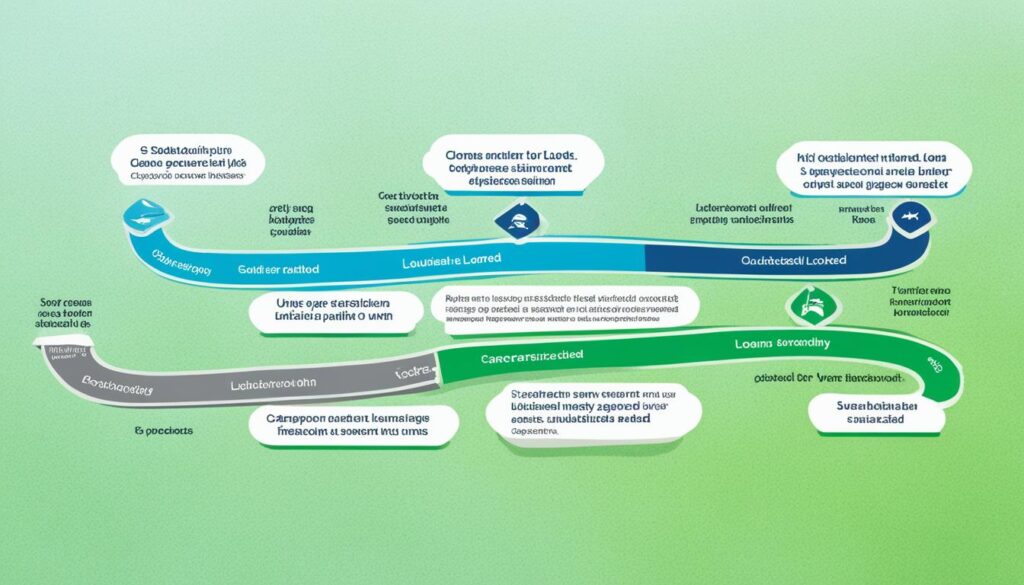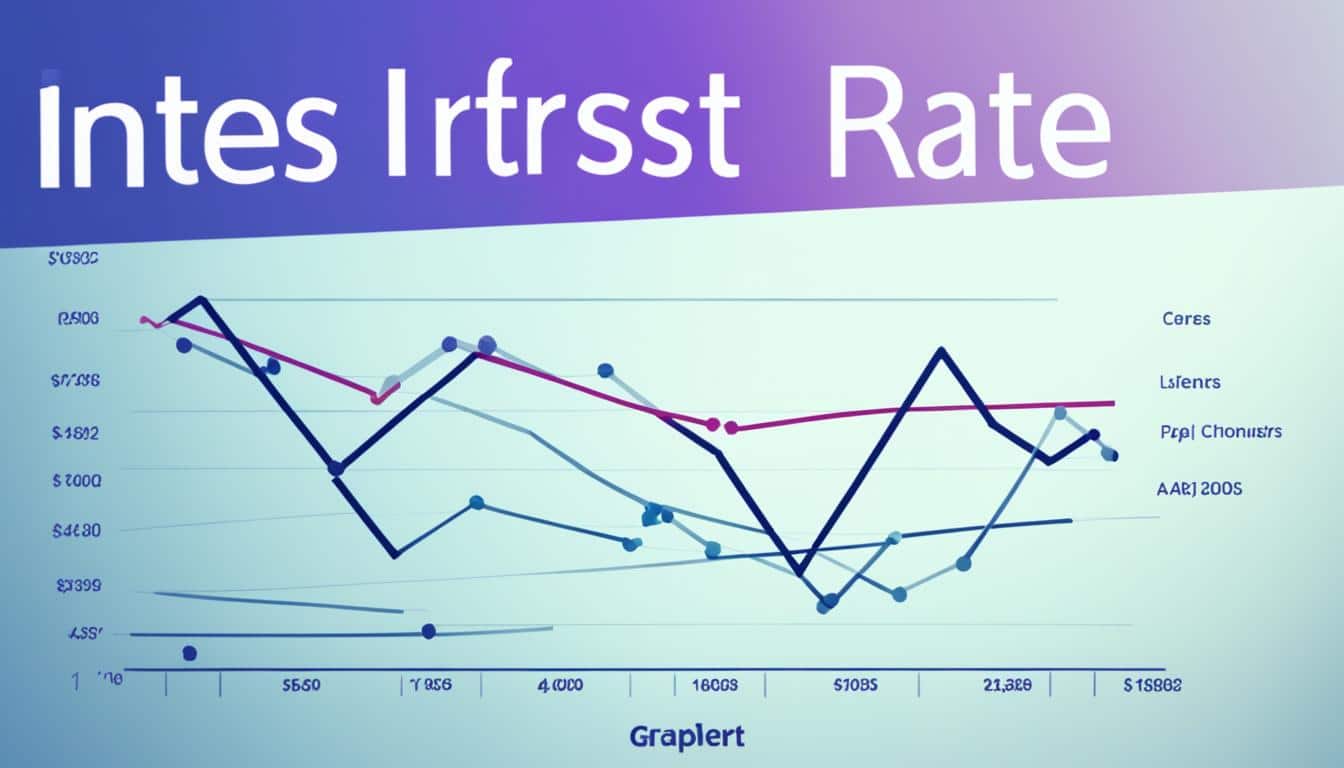The cost of going to college keeps going up. More students are looking at loans to help pay for school. The government offers both subsidized and unsubsidized student loans. Knowing about loan subsidies can help students make better choices when it comes to paying for college.
A loan subsidy means the government helps lower the interest rate or the total cost of a loan. This kind of help makes loans cheaper and easier to get for students and their families. By learning about the perks of subsidized loans, students can get ready for the money side of going to college.
Key Takeaways
- Loan subsidies can lower interest rates and monthly payments, making college more affordable.
- Subsidized loans are available to eligible undergraduate students based on financial need.
- Subsidized loans do not accrue interest while the borrower is enrolled in school, during the grace period, or during periods of deferment.
- Unsubsidized loans are available to all eligible students, regardless of financial need, but interest accrues from the time of disbursement.
- Understanding the differences between subsidized and unsubsidized loans can help borrowers make informed decisions about their college financing options.
Understanding Loan Subsidies
A loan subsidy is financial help from the government to make loans cheaper. It can lower interest rates or cover some interest costs. This makes loans easier to handle, especially for those with little money.
What is a Loan Subsidy?
A loan subsidy lowers the cost of a loan for the borrower. The government might pay some of the interest. This cuts down the total loan cost, making it easier for borrowers to pay.
Types of Loan Subsidies
There are many kinds of loan subsidies, each for different needs. Here are some common ones:
- Federal Student Loan Subsidies: The U.S. government gives these for certain federal student loans, like Direct Subsidized Loans. They pay the interest while you’re in school, during grace periods, and when loans are deferred.
- Government Loan Subsidies: Governments offer subsidies for loans like mortgages, small business loans, or personal loans. These help make loans cheaper for people or businesses needing financial help.
- Income-Driven Repayment Plans: Some federal student loan plans, like the Revised Pay As You Earn (REPAYE) plan, have an interest subsidy. The government might pay part of the interest, lowering the total cost for you.
Knowing about loan subsidies helps borrowers choose the best financing options for their needs and budget.
Subsidized Student Loans
Subsidized student loans help undergraduate students who really need them. The government gives out these loans with benefits that can change a student’s education path. It’s key to know who can get these loans and how they work to make smart choices about paying for college.
Eligibility for Subsidized Loans
To get subsidized student loans, students must fill out the Free Application for Federal Student Aid (FAFSA) and show they need financial help. This means looking at the student’s and their family’s income, assets, and other money matters. Then, the government decides how much money the student can borrow based on their financial need.
How Subsidized Loans Work
- While students are in school half-time or more, the government pays the loan’s interest.
- After school, there’s a 6-month break where the government still covers the interest.
- This break and the interest help keep the total debt lower, making these loans a better choice for students.
Subsidized student loans are great for many students who need help paying for school. They’re based on financial need and come with a government interest subsidy. This makes them a good way to finance education without taking on too much debt.
| Benefit | Description |
|---|---|
| Interest Subsidy | The government pays the interest on the loans while the student is enrolled at least half-time and during the 6-month grace period after graduation. |
| Need-Based Eligibility | Borrowers must demonstrate financial need by completing the FAFSA to qualify for subsidized loans. |
| Reduced Debt Burden | The interest subsidy and grace period help minimize the total amount of debt the borrower has to repay, making subsidized loans more affordable. |
Benefits of Subsidized Loans
Subsidized loans have many benefits for students. One big plus is that the government pays the interest while you’re in school or during grace periods. This can save you a lot of money over time.
These loans also have lower interest rates than unsubsidized ones. The government sets a fixed rate that’s usually lower than what you’d get with other loans. This makes your monthly payments easier to handle.
Being able to pause your loan payments is another great thing about subsidized loans. If you’re struggling financially, you might be able to stop making payments. This can prevent you from falling behind on your loans.
| Benefit | Description |
|---|---|
| Interest Subsidy | The government pays the interest on the loan while the borrower is in school, during the grace period, and potentially during periods of deferment or forbearance. |
| Lower Interest Rates | Subsidized loans typically have a fixed interest rate set by the government, which is generally lower than the variable rates of unsubsidized loans. |
| Deferment and Forbearance | Borrowers may be able to temporarily defer or postpone repayment during times of financial hardship, such as periods of unemployment or underemployment. |
Subsidized loans can make going to college more affordable and flexible. They help ease the financial stress of getting an education. By knowing the benefits, you can choose the best loan for your needs.
Unsubsidized Student Loans
Unlike subsidized federal student loans, unsubsidized loans go to both undergrad and grad students, no matter their financial need. To get an unsubsidized loan, students must fill out the Free Application for Federal Student Aid (FAFSA).
Eligibility for Unsubsidized Loans
Getting unsubsidized student loans doesn’t depend on financial need. Any student taking at least half-time classes in an approved program can apply. The amount you can borrow depends on your grade level and if you’re considered dependent or independent.
How Unsubsidized Loans Work
Unsubsidized loans start adding up interest right after you get the money, even if you’re still in school. You can pay the interest while you’re studying, but you don’t have to. This means you’ll owe more money at the end than with subsidized loans.
| Loan Type | Interest Accrual | Repayment Options |
|---|---|---|
| Subsidized Loans | No interest accrues while in school | Borrower can defer payments until after graduation |
| Unsubsidized Loans | Interest accrues immediately | Borrower can choose to pay interest while in school or defer until after graduation |
Knowing the differences between subsidized and unsubsidized student loans helps borrowers make smart choices about paying for school. It also helps with managing their unsubsidized loan payments.
Loan Subsidy

A loan subsidy can greatly reduce the cost of student loans. The government offers this benefit by covering some or all of the interest. This means borrowers save a lot of money over the life of their loans.
There are two main types of loan subsidies for students:
- Subsidized Federal Student Loans: These loans, given by the U.S. Department of Education, don’t have interest while you’re in school, during the grace period, or when payments are paused.
- Income-Driven Repayment Plans: Some repayment plans, like REPAYE and PAYE, offer an interest subsidy. This can greatly lower the interest for borrowers with lower incomes.
The loan subsidy and government student loan subsidy from these options can save a lot of money over the life of your loans. They are a great choice for those wanting to cut down on interest subsidy on loans.
| Loan Subsidy Type | Description | Key Benefits |
|---|---|---|
| Subsidized Federal Student Loans | Loans where the government pays the interest while the borrower is in school, in the grace period, or in deferment | Reduced total loan cost, lower monthly payments |
| Income-Driven Repayment Plans | Federal repayment plans that cap monthly payments based on income and provide interest subsidies | Affordable payments, potential for loan forgiveness |
“The loan subsidy provided by the government can be a game-changer for students, helping them manage their debt and achieve their financial goals.”
Comparing Subsidized and Unsubsidized Loans

There are two main types of federal student loans: subsidized and unsubsidized. Knowing the differences between subsidized vs unsubsidized loans helps you choose the right one for your education.
The main difference is how interest works on the loans. With subsidized loans, the government pays the interest while you’re in school, during your grace period, and during any deferment periods. This can lower the total amount you’ll repay. Unsubsidized loans, however, start accruing interest right away, even when you’re still in school.
| Feature | Subsidized Loans | Unsubsidized Loans |
|---|---|---|
| Interest Accrual | The government pays the interest during school, grace period, and deferment. | Interest starts accruing immediately. |
| Eligibility | Based on financial need. | Available to all students, regardless of financial need. |
| Borrowing Limits | Lower maximum borrowing limits. | Higher maximum borrowing limits. |
| Total Debt Load | Generally results in a lower total debt load for the borrower. | May result in a higher total debt load for the borrower. |
Subsidized loans are given to students who need them based on their financial situation. Unsubsidized loans are open to all students, with or without financial need. So, if you don’t get subsidized loans, you can still get unsubsidized ones to pay for school.
Choosing between subsidized vs unsubsidized loans depends on your financial situation and goals. Think about the pros and cons of each to make the best choice for you.
Income-Driven Repayment Plans
The government offers income-driven repayment (IDR) plans along with subsidized federal student loans. These plans help borrowers who are struggling to pay by lowering their monthly payments.
REPAYE Plan
The REPAYE plan has the government pay all the interest on subsidized loans for up to three years. After that, it pays 50% of the interest. This can greatly help borrowers by reducing the total cost of their debt.
PAYE and IBR Plans
The PAYE and IBR plans also offer an interest subsidy. The government covers the remaining interest on subsidized loans for up to three years. These plans are made for borrowers with lower incomes to make repaying loans easier.
| Repayment Plan | Interest Subsidy |
|---|---|
| REPAYE | Government pays all interest on subsidized loans for up to 3 years, then 50% thereafter |
| PAYE and IBR | Government covers remaining interest on subsidized loans for up to 3 years |
These income-driven repayment plans can really help borrowers. They offer relief and make repaying student loans easier over time.
Applying for an Income-Driven Repayment Plan

If you’re finding it hard to pay back your student loans, an income-driven repayment (IDR) plan could help. These plans adjust your monthly payments based on your income and family size. But, you need to put in some work to get and keep an IDR plan.
To join an IDR plan, you must apply through the Federal Student Aid office. You’ll need to share details about your income and family size. After getting approved, you’ll have to recertify your IDR plan every year with new financial info. If you don’t recertify on time, you could lose the IDR plan’s benefits.
- Learn how to apply for an IDR plan through the Federal Student Aid office.
- Understand the importance of recertifying your IDR plan annually to keep the benefits.
- Familiarize yourself with the income-driven repayment plan application process and what documents you need.
By taking the time to apply for an IDR plan and recertify it annually, you can enjoy lower monthly payments and possibly even loan forgiveness. Don’t let the application scare you – it’s a smart move for your financial future.
Understanding Loan Repayment Terms
Managing student loan debt has several options for federal loan borrowers. The standard 10-year repayment plan is a common choice. But, borrowers can also pick a graduated repayment plan with lower initial payments. There are also income-driven repayment plans with their own rules.
It’s key to know the details of each plan. This includes the monthly payment, how long you’ll pay, and the total interest. By looking at these details, borrowers can pick a plan that fits their financial situation and goals.
| Repayment Plan | Monthly Payment | Repayment Period | Total Interest Paid |
|---|---|---|---|
| Standard 10-year Plan | $X | 10 years | $X |
| Graduated Repayment Plan | Starts at $X, increases every 2 years | 10 years | $X |
| Income-Driven Repayment (REPAYE) | 10% of discretionary income | Up to 25 years | $X |
Knowing about student loan repayment terms helps borrowers make smart choices. This way, they can manage their loans well and reach their financial goals.
“Staying on top of your student loan repayment plan is crucial for maintaining financial stability and achieving your long-term goals.”
Refinancing Options
For borrowers wanting to lower their interest rates and monthly payments, refinancing student loans is an option. By refinancing private student loans, people might get a better deal and save money. But, it’s important to know the benefits of refinancing and the possible downsides.
Federal student loans come with protections and repayment plans based on income. When refinancing federal student loans to a private loan, these benefits might be lost. It’s key to think about the good and bad before deciding.
- Potential to lower interest rates and monthly payments
- Ability to consolidate multiple loans into a single payment
- Flexible repayment terms, such as extended or shortened loan periods
- Loss of federal loan benefits, including income-driven repayment plans and loan forgiveness programs
- Ineligibility for future federal loan programs and protections
Deciding to refinance student loans should depend on your financial situation, goals, and how much risk you can handle. By looking at the pros and cons, you can make a choice that fits your needs.
Also Read: What Documents Are Needed For A Mortgage Loan?
“Refinancing can be a powerful tool for borrowers, but it’s crucial to understand the trade-offs before making a decision.”
Conclusion
Loan subsidies, especially for federal student loans, offer big benefits to borrowers. They keep interest costs low while you’re in school and during the grace period. This makes them a smart choice.
It’s important to know the different loan types and how to repay them. This helps you manage your student debt and get the most from benefits of a loan subsidy. By looking into the various subsidies, you can find the best way to pay for your education.
If you’re in school or just graduated, it’s key to understand how loan subsidies work. Making smart choices about your loans can help you succeed. It sets you up for your future and helps you reach your goals.
FAQs
Q: What is a direct subsidized loan?
A: A direct subsidized loan is a type of federal student loan where the federal government pays the loan interest while the borrower is in school at least half-time, during the grace period, and during deferment periods.
Q: What are the benefits of a direct subsidized loan?
A: The main benefit of a direct subsidized loan is that the federal government pays the interest on the loan during specific periods, making it a more affordable option compared to other types of loans.
Q: How do I apply for a subsidized loan?
A: To apply for a direct subsidized loan, you need to complete the Free Application for Federal Student Aid (FAFSA) form. Your school will then review your application and determine your eligibility for the loan.
Q: What is the loan limit for a direct subsidized loan?
A: The loan limit for a direct subsidized loan depends on your year in school and whether you are a dependent or independent student. The specific loan limits are set by the Department of Education.
Q: Can I choose between a direct subsidized and direct unsubsidized loan?
A: Yes, when applying for federal student aid, you may be offered both direct subsidized and direct unsubsidized loans. It is important to understand the differences between the two types of loans before making a decision.
Q: What are the interest rates and fees associated with direct subsidized loans?
A: Direct subsidized loans have fixed interest rates, which are set by the government each year. Additionally, there may be loan origination fees associated with the loan, depending on when the loan is disbursed.
Q: How do I know if I am eligible for a direct subsidized loan?
A: To be eligible for a direct subsidized loan, you must demonstrate financial need based on the information provided in your FAFSA form. Your school will determine your eligibility for the loan.
Source Links
- https://fortune.com/recommends/loans/subsidized-vs-unsubsidized-student-loans/
- https://www.investopedia.com/personal-finance/federal-direct-loans-subsidized-vs-unsubsidized/
- https://www.lendingtree.com/student/federal-loan-interest-subsidy/